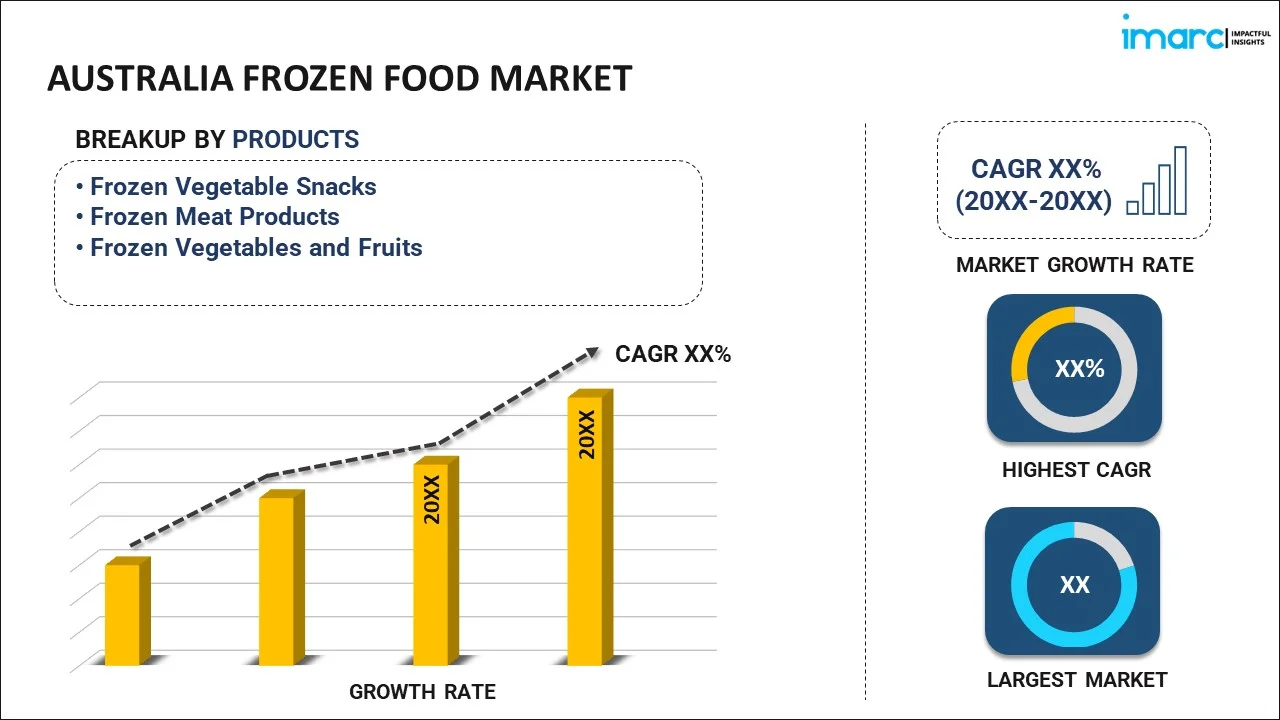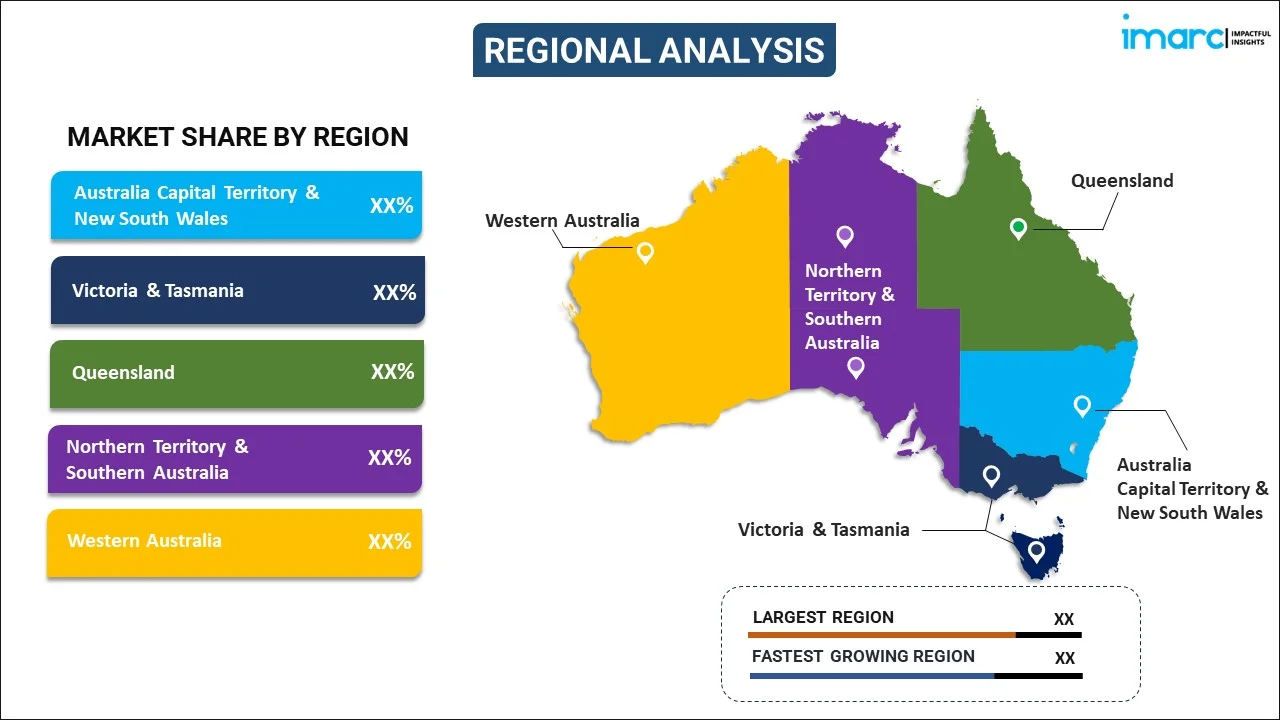
Australia Frozen Food Market Report by Product (Frozen Vegetable Snacks, Frozen Meat Products, Frozen Vegetables and Fruits), and Region 2025-2033
Market Overview:
Australia frozen food market size reached USD 4.4 Billion in 2024. Looking forward, IMARC Group expects the market to reach USD 8.2 Billion by 2033, exhibiting a growth rate (CAGR) of 6.70% during 2025-2033. The introduction of attractive and sustainable packaging solutions and the expanding cold chain infrastructures are primarily catalyzing the market growth across the country.
|
Report Attribute
|
Key Statistics
|
|---|---|
|
Base Year
|
2024
|
|
Forecast Years
|
2025-2033
|
|
Historical Years
|
2019-2024
|
|
Market Size in 2024
|
USD 4.4 Billion |
|
Market Forecast in 2033
|
USD 8.2 Billion |
| Market Growth Rate 2025-2033 | 6.70% |
Frozen food products encompass various items kept under low temperatures for prolonged preservation. They include fruits, vegetables, edible roots, ready-to-eat meals, seafood, bakery goods, snacks, desserts, etc. The process of freezing serves as an effective means of preserving nutrients, allowing these food products to maintain their nutritional value over an extended period. One notable advantage is the accessibility of a diverse range of seasonal items throughout the year, irrespective of their natural availability. This provides consumers with the flexibility to enjoy a variety of foods at any given time. Additionally, the convenience of using only the necessary amount of frozen food helps in curbing food waste. This aspect aligns with the principle of minimizing wastage by allowing consumers to utilize portions as needed, contributing to a more sustainable and resource-efficient approach in the consumption of food products.
Australia Frozen Food Market Trends:
The Australia frozen food market is primarily driven by the several key factors. Firstly, the changing lifestyle choices and the increasing demand for convenient and time-saving food options are augmenting the market growth across the country. Additionally, technological advancements in freezing and packaging techniques play a pivotal role in enhancing the overall quality and shelf life of frozen food products. Besides this, innovations, such as quick-freezing methods and advanced packaging materials, contribute to preserving the nutritional content and taste, meeting the evolving preferences of consumers across Australia. Furthermore, the elevating concerns among individuals towards food safety and longer shelf life are acting as significant growth-inducing factors. Apart from this, consumers are increasingly adopting frozen food items, due to their perceived safety and extended storage capabilities, thereby driving the market growth in the country. Moreover, strategic collaborations and partnerships between frozen food manufacturers and retailers contribute to the market expansion. These alliances not only strengthen the distribution networks but also increase product visibility and accessibility for consumers, which in turn, is anticipated to fuel the Australia frozen food market over the forecasted period.
Australia Frozen Food Market Segmentation:
IMARC Group provides an analysis of the key trends in each segment of the market, along with forecasts at the country level for 2025-2033. Our report has categorized the market based on product.
Product Insights:

- Frozen Vegetable Snacks
- French Fries
- Bites, Wedges and Smileys
- Aloo Tikki
- Nuggets
- Others
- Frozen Meat Products
- Chicken
- Fish
- Pork
- Mutton
- Others
- Frozen Vegetables and Fruits
- Breakup by Frozen Vegetables
- Green Peas
- Corn
- Mixed Vegetables
- Carrot
- Cauliflower
- Others
- Breakup by Frozen Fruits
- Strawberries
- Berries (Raspberries, Blueberries and Blackberries)
- Cherries
- Others
- Breakup by Frozen Vegetables
The report has provided a detailed breakup and analysis of the market based on the product. This includes frozen vegetable snacks (french fries, bites, wedges and smileys, aloo tikki, nuggets, and others), frozen meat products (chicken, fish, pork, mutton, and others), and frozen vegetables and fruits [breakup by frozen vegetables (green peas, corn, mixed vegetables, carrot, cauliflower, and others), breakup by frozen fruits (strawberries, berries (raspberries, blueberries and blackberries), cherries, and others)].
Regional Insights:

- Australia Capital Territory & New South Wales
- Victoria & Tasmania
- Queensland
- Northern Territory & Southern Australia
- Western Australia
The report has also provided a comprehensive analysis of all the major regional markets, which include Australia Capital Territory & New South Wales, Victoria & Tasmania, Queensland, Northern Territory & Southern Australia, and Western Australia.
Competitive Landscape:
The market research report has also provided a comprehensive analysis of the competitive landscape in the market. Competitive analysis such as market structure, key player positioning, top winning strategies, competitive dashboard, and company evaluation quadrant has been covered in the report. Also, detailed profiles of all major companies have been provided.
Australia Frozen Food Market Report Coverage:
| Report Features | Details |
|---|---|
| Base Year of the Analysis | 2024 |
| Historical Period | 2019-2024 |
| Forecast Period | 2025-2033 |
| Units | Billion USD |
| Scope of the Report | Exploration of Historical Trends and Market Outlook, Industry Catalysts and Challenges, Segment-Wise Historical and Future Market Assessment:
|
| Products Covered |
|
| Regions Covered | Australia Capital Territory & New South Wales, Victoria & Tasmania, Queensland, Northern Territory & Southern Australia, Western Australia |
| Customization Scope | 10% Free Customization |
| Post-Sale Analyst Support | 10-12 Weeks |
| Delivery Format | PDF and Excel through Email (We can also provide the editable version of the report in PPT/Word format on special request) |
Key Questions Answered in This Report:
- How has the Australia frozen food market performed so far and how will it perform in the coming years?
- What has been the impact of COVID-19 on the Australia frozen food market?
- What is the breakup of the Australia frozen food market on the basis of product?
- What are the various stages in the value chain of the Australia frozen food market?
- What are the key driving factors and challenges in the Australia frozen food?
- What is the structure of the Australia frozen food market and who are the key players?
- What is the degree of competition in the Australia frozen food market?
Key Benefits for Stakeholders:
- IMARC’s industry report offers a comprehensive quantitative analysis of various market segments, historical and current market trends, market forecasts, and dynamics of the Australia frozen food market from 2019-2033.
- The research report provides the latest information on the market drivers, challenges, and opportunities in the Australia frozen food market.
- Porter's five forces analysis assist stakeholders in assessing the impact of new entrants, competitive rivalry, supplier power, buyer power, and the threat of substitution. It helps stakeholders to analyze the level of competition within the Australia frozen food industry and its attractiveness.
- Competitive landscape allows stakeholders to understand their competitive environment and provides an insight into the current positions of key players in the market.
Need more help?
- Speak to our experienced analysts for insights on the current market scenarios.
- Include additional segments and countries to customize the report as per your requirement.
- Gain an unparalleled competitive advantage in your domain by understanding how to utilize the report and positively impacting your operations and revenue.
- For further assistance, please connect with our analysts.
 Inquire Before Buying
Inquire Before Buying
 Speak to an Analyst
Speak to an Analyst
 Request Brochure
Request Brochure
 Request Customization
Request Customization




.webp)




.webp)












